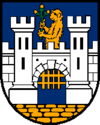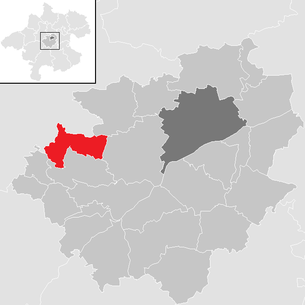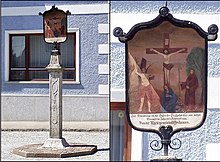Offenhausen (Upper Austria)
|
market community Offenhausen
|
||
|---|---|---|
| coat of arms | Austria map | |
|
|
||
| Basic data | ||
| Country: | Austria | |
| State : | Upper Austria | |
| Political District : | Catfish Land | |
| License plate : | WL | |
| Surface: | 15.05 km² | |
| Coordinates : | 48 ° 9 ' N , 13 ° 50' E | |
| Height : | 386 m above sea level A. | |
| Residents : | 1,711 (January 1, 2020) | |
| Population density : | 114 inhabitants per km² | |
| Postal code : | 4625 | |
| Area code : | 07247 | |
| Community code : | 4 18 14 | |
| NUTS region | AT312 | |
| Address of the municipal administration: |
Market community Offenhausen Gemeindeplatz 1 4625 Offenhausen |
|
| Website: | ||
| politics | ||
| Mayor : | Johann Stürzlinger ( ÖVP ) | |
|
Municipal Council : (2015) (19 members) |
||
| Location of Offenhausen in the Wels-Land district | ||
| Source: Municipal data from Statistics Austria | ||
Offenhausen is a market town in Upper Austria in the Wels-Land district in the Hausruckviertel with 1711 inhabitants (as of January 1, 2020). The community belonged to the judicial district of Lambach until 2012 and has been part of the judicial district of Wels since January 1, 2013 .
geography
Offenhausen lies at an altitude of 386 m above sea level. A. in the Grünbachtal, embedded in the hilly foothills of the Hausruck . It extends five kilometers from north to south and seven kilometers from west to east. The total area is 15.1 square kilometers. 17.9 percent of the area is forested, 70.9 percent of the area is used for agriculture. The municipality is traversed by the Grünbach from west to east .
Neighboring communities are Kematen am Innbach and Pichl bei Wels in the north, Gunskirchen in the east, Pennewang in the south and Meggenhofen and Bachmanning in the west .
The district capital Wels is about 17 kilometers to the east and can be reached via the well-developed Grünbachtal state road.
Community structure
The municipality includes the following 32 localities (population in brackets as of January 1, 2020):
- Aigen (11)
- Amesberg (1)
- Balding (26)
- Eglsee (8)
- Großkrottendorf (139)
- Pit (19)
- Haindorf (26)
- Hoelking (9)
- Humplberg (11)
- Kapsam (10)
- Kleinkrottendorf (11)
- Kohlboeckhof (12)
- Kronberg (6)
- Kurzenkirchen (9)
- Linet (20)
- Maierhof (9)
- Moss (63)
- Obereggen (8)
- Offenhausen (1067)
- Osterberg (17)
- Paschlberg (9)
- Pfaffendorf (43)
- Sittenthal (9)
- Stockerberg (2)
- Stritzing (3)
- Untereggen (22)
- Voglsang (17)
- Front wood (6)
- Vineyard (48)
- Wies (3)
- Wieshausl (35)
- Würting (32)
The community consists of the cadastral communities Großkrottendorf , Humplberg , Offenhausen and Würting.
geology
The municipality of Offenhausen is located in the Upper Austrian Molasse Zone. As in other places in the region around Wels, an oil and gas field was discovered in Offenhausen by the Rohöl-Aufsuchungs AG in the 1960s . While the oil production facility near Pfaffendorf was dismantled at the end of the 1990s due to economic unprofitability, the Offenhausen gas field has been supplying natural gas for the Upper Austrian gas network to date.
Population development
According to Statistics Austria, the municipality already had 1,424 inhabitants in 1869, but the number fell to 1,252 by 1981. From the end of the 1980s to the beginning of the 2010s, the population increased (census in 1991: 1340 inhabitants, 2001: 1546 inhabitants, 2011: 1607 inhabitants), since then it has stagnated at just over 1600 inhabitants.
Town twinning
-
 Offenhausen (Middle Franconia) in Bavaria , Germany, since 2001
Offenhausen (Middle Franconia) in Bavaria , Germany, since 2001
coat of arms
Official description of the municipal coat of arms : In blue on a golden, stony shield base a silver, two-towered, square and tinned gate, each tower with three black open windows, two placed above one, the openwork wall gate with half-raised, golden portcullis; on the battlements above the gate a golden, growing monkey, holding a green branch with three golden acorns in its front paws .
It is not known when the coat of arms was awarded. The old market coat of arms, traceable since 1579, showed a sitting monkey turned to the left, holding a branch with three acorns in its left paw. The representation in use today can be found for the first time on a seal from 1637. The symbolization of the place name by the representation of a monkey is one of the absurd " talking " interpretations of folk etymology .
history
So far, no prehistoric traces of any kind have come to light in the municipality of Offenhausen. In Roman times, a Roman road is said to have run between the cities of Ovilava ( Wels ) and Castra Regina ( Regensburg ) through Offenhausen's municipal area. It presumably led from Wels to the heights of the western hilly country, past the village of Burgstall (Kematen) on the forest path in the Vornholzer Forest, which is still known today by the locals as the "Roman road", on via Geboltskirchen to the western branch of the Hausruck Forest to Burghausen , Neuötting ( lat. Turum) and finally to Regensburg (Castra Regina). Place names that end in -ing, -ham, -hausen, -kirchen or -dorf, as they are represented in the municipality, indicate an early Bavarian settlement from the 6th century.
In 814 the Würting Castle was first mentioned in writing ('actum ad wirtingen'); The first documented mention of Offenhausen is documented in 1140: Liupertus von Offenhausen is named as a witness in a deed of donation. The patronage of the parish church of St. Stefan points to the foundation of Passau (St. Stephen's Cathedral), to whose diocese Offenhausen belonged at this time. In 1359 Offenhausen was separated from the mother parish of Pichl near Wels and was first mentioned in writing as a separate parish.
On November 12, 1534, the village of Offenhausen received a market privilege. Jörg III. von Perkheim, owner of the Würting lordship, was raised to market status by King Ferdinand I at the request of the residents and through his intercession for the village that was subject to him. This had developed into a regional center of trade, industry and handicrafts. In his will, Jörg III donated. von Perkheim also established the first school in Offenhausen in 1559 (“common school”) - 215 years before the general compulsory schooling introduced in 1774 under Maria Theresa . In 1620 the army of the Catholic League coming from Bavaria devastated the Hausruckviertel . Offenhausen was particularly badly affected by more than a hundred destroyed villages. In 1687 Johann Maximus Steiner von Pleyfelden, Auxiliary Bishop in Passau , inaugurated the parish church of Offenhausen, which was restored and equipped with new altars. In 1751–1754, evangelical residents were forced to move to Transylvania.
In 1800 there were already 1,273 Catholics living in the Offenhausen parish. In 1830 there were 234 houses with 338 tenants in the Offenhausen parish, in which 1345 residents lived, 95 of them in the market with 112 tenants and 569 residents. As in other markets and cities at that time, Offenhausen also had a hospital where citizens could be fed in the event of illness or poverty. At the end of the 18th and the beginning of the 19th century Offenhausen achieved a certain fame through the workshops of the “Tischler in Aigen” and “Tischler in Moos”. Georg Praitwieser (1768–1849) in particular, with his artistically painted furniture, is one of the most important representatives of Upper Austrian 'peasant furniture'.
In 1889 the local kindergarten was founded (at that time: "Kinderbewahranstalt"), where Johann Karl Grillmayr, the owner of Würting Castle, made a special contribution. In 1927 a swimming pool and a public bath tub were built. From its opening in 1889 to 1996, the Offenhausen Kindergarten was mostly run by two Sisters of the Cross . Due to the increasing number of children and the existing lack of space, a new building was necessary at the end of the 1990s. In 2002 the new kindergarten building on the grounds of the rectory garden was officially opened.
The right-wing extremist association Dichterstein Offenhausen laid the so-called Dichtersteinanlage east of the town in 1963. The annual club meetings were attended by right-wing extremists and neo-Nazis from all over Europe. In 1999 the association was officially dissolved due to re- activating the NS .
In 1990, on the occasion of an action by the Upper Austrian provincial government, Offenhausen was chosen as the heart village of Upper Austria. Ceiling pictures of a coffered ceiling from the Würting Castle that were believed to be lost were secured in 1995 by the 'Denkmalpflege Oberösterreich' association with the help of the state and the federal government through a rescue purchase. The aim of the Federal Monuments Office is to reinstall it in Würting Castle, if appropriate conditions for the presentation are created there.
politics
The municipal council of the market community Offenhausen consists of 19 members, of which the ÖVP has 11 mandates, the FPÖ 7 mandates and the SPÖ 1 mandate.
- mayor
- until 2015 Hermann Stoiber (ÖVP)
- since 2015 Johann Stürzlinger (ÖVP)
In June 2020, Mayor Johann Stürzlinger announced his retirement, and Vice Mayor Martina Schmuckermayr will succeed him.
Culture and sights
- Würting Castle : an important moated castle that dates back to the 9th century and was redesigned in the Renaissance style until 1610
- Parish church hl. Stephan : In the Austrian topography of art, the parish church is referred to as “perhaps the most important market church in Upper Austria in Renaissance style”. High altar painting from 1754 by Bartolomeo Altomonte . It shows the stoning of St. Stephen.
- Historical laundry pool : The laundry pool was first called Weyerl (= pond) in 1455 . The name Wösch (= laundry pool ) has been handed down from 1662 .
- Plague column: on the market square
- Market fountain with Christophorus statue: on the market square
- Emperor Franz Josef anniversary oak : in the immediate vicinity of the laundry pool, an oak was planted by the citizens of the market in 1908 on the occasion of the 60th anniversary of the throne of Emperor Franz-Josef I.
- Filial church of St. Vitus: The branch church belonging to the parish Meggenhofen is located on the Veitsberg in the municipality of Offenhausen. The church has a baroque onion-type dome and inside it has three remarkable baroque altars.
- The Offenhausen Heimatverein organizes theater performances.
Sports
The Offenhausen sports club consists of the tennis, shooting and football sections. In Offenhausen there are two tennis courts, a shooting range, an asphalt floor hall, a gym, a beach volleyball court, a multi-purpose hard rubber court, a soccer field and the "Grünbachtalstadion". There has been an outdoor swimming pool in the village since 1927. Signposted hiking trails lead into the rolling hills around Offenhausen.
Personalities
- Sons and daughters
- Jörg III. von Perkheim (1485–1559), owner of the Würting Castle, member of the Linz state parliament and its representative on several imperial diets (Regensburg, Speyer, Augsburg), champion of the Protestant cause, achieved the market uprising of Offenhausen with King Ferdinand I in 1534 , founded the Offenhausen elementary school (“common” school) and considered other charitable foundations in his will.
- Klothilde (Lotte) Kiener (1891–1980), dialect poet. Originated from the Aichergut in Großkrottendorf. 1975 Awarded the Gold Medal of Honor of the Stelzhamerbund. She lived in Gallspach since 1926 , where she ran a guesthouse.
- Matthias Mühlbacher (1899–1957), builder of the sawmill hall, which is now used as a concert and event hall, and Mathilde Schwabeneder's grandfather.
- Hans Reinthaler (1900–1964), dialect poet, narrator, playwright
- Franz (Balduin) Reinthaler (1901–1969), painter and pastor in Carinthia
- Anton Reinthaler (* 1950), choirmaster, organist and composer, from 1986 to 2003 cathedral music director at the Linz Mariendom , painter
- Othmar Commenda (* 1954), General a. D., from May 2013 to June 2018 Chief of the General Staff of the Austrian Armed Forces .
- Mathilde Schwabeneder (* 1956), ORF correspondent and head of the ORF branch in Rome, author.
- Peter Schierl, employee of the World Bank in Washington and film producer (“One of us”, film about the life of Franz Jägerstätter ).
- Ivona Dadic (* 1993), track and field athlete and multiple national champion in heptathlon .
- Famous People Related to Offenhausen
- King Ferdinand I (1503–1564) granted Offenhausen market rights in 1534
- Christoph Weiß (1559–1617), wealthy merchant and bailiff of Wels , acquired Würting Castle in 1604 and had it rebuilt in the Renaissance style until 1610 in the appearance that has been preserved to this day
- Bartolomeo Altomonte (1694–1783), painter, created the high altar picture in the parish church in 1754
- Georg Praitwieser (also spellings: Praitwiser, Preitwieser, Breitwieser) (1768–1849), master carpenter and painter, as "Carpenter in Moos" one of the most important representatives of Upper Austrian 'peasant furniture'.
- Johann Karl Grillmayer (1862–1915), son of the founder of the Kleinmünchen spinning mill (today Linz Textil AG), owner of Würting Castle, great charitable benefactor a. a. in Offenhausen
- Arthur Kaufmann (1872–1938), chess player, enjoyed the Gutmann family's hospitality at Würting Castle for 10 years
- Paul Kammerer (1880–1926), biologist, spent several summers at Würting Castle and was nicknamed "Toad Kisser" here.
- Richard Nikolaus Coudenhove-Kalergi (1894–1972) wrote his programmatic work Pan-Europa in 1923 at Würting Castle in Offenhausen
Panorama picture
Web links
- Entry on Offenhausen (Upper Austria) in the Austria Forum (in the AEIOU Austria Lexicon )
- Karl Müller: Austria anno domini 1998/99. ( Memento from March 17, 2015 in the Internet Archive ) Expertise on the "Verein Dichterstein Offenhausen"
- 41814 - Offenhausen (Upper Austria). Community data, Statistics Austria .
- More information about the community of Offenhausen (Upper Austria) on the geographic information system of the federal state of Upper Austria .
Individual evidence
- ↑ Statistics Austria: Population on January 1st, 2020 by locality (area status on January 1st, 2020) , ( CSV )
- ↑ Natural gas: from chance discovery to systematic drilling activity in the forum OoeGeschichte.at
- ↑ Article "200 years of gas supply" in the OÖN, November 28, 2009
- ↑ www.wabweb.net Natural gas and oil in Austria
- ↑ Festschrift "75 Years of Energy from the Deep 1935–2010", RAG ( Memento of the original from August 21, 2011 in the Internet Archive ) Info: The archive link was inserted automatically and has not yet been checked. Please check the original and archive link according to the instructions and then remove this notice.
- ↑ http://www.statistik.at/blickgem/blick1/g41814.pdf
- ^ Province of Upper Austria: Detailed description of the coat of arms
- ↑ History of the introduction and spread of Christianity in southeast Germany, by Dr. Alois Huber, third volume. Baivaren time. Christianization of Altbaivarias. Salzburg 1874, p. 30
- ↑ Note sheet. Supplement to the archive for customers of Austrian historical sources. Vienna 1851.
- ^ A b Max Doblinger: Jörg von Perkheim, a class diplomat of the 16th century. In: Yearbook of the Upper Austrian Museum Association. Linz 1951, online (PDF) in the forum OoeGeschichte.at
- ^ History of the Principality of Passau: History from the 14th Century to Secularization, Volume 2 , Johann Nepomuk Buchinger , Munich 1824
- ^ Franz Gratzer, Cryptoprotestantism in Upper Austria, S54
- ↑ Chronological Necrologium of the clergymen who have died in the Diocese of Linz since 1785, Linz 1887
- ^ History, geography and statistics of the Archduchy of Austria ob der Enns, Linz 1830
- ^ History, geography and statistics of the Archduchy of Austria ob der Enns, Linz 1830 , accessed from the Upper Austria homepage. State Library on July 29, 2017.
- ^ Upper Austrian farm furniture, Franz C. Lipp, Vienna 1986
- ↑ Georg Praitwieser's golden pagoda cabinet
- ↑ Sumerauerhof open-air museum, St. Florian
- ^ The ceiling pictures of Würting Castle - A crime story that has not yet been written ( Memento from March 23, 2004 in the Internet Archive )
- ^ Gertrude Paltinger: Mayor Johann Stürzlinger resigns from his office. In: tips.at. June 24, 2020, accessed June 24, 2020 .
- ↑ Offenhausen: Stürzlinger resigns surprisingly. In: Upper Austrian news . June 24, 2020, accessed June 24, 2020 .
- ↑ Offenhausen Theater
- ^ Günter Merz: The struggle to enforce the Reformation in Upper Austria (~ 1527–1568) in the forum OoeGeschichte.at
- ^ AEIOU - Austria Lexicon
- ^ Anton Reinthaler. Retrieved June 9, 2017 .
- ↑ http://www.nachrichten.at/nachrichten/politik/innenpolitik/Othmar-Commenda-Wir-brauchen-mehr-Soldaten;art385,2069281
- ↑ ORF customer service ( Memento from March 4, 2016 in the Internet Archive )
- ↑ http://blogs.worldbank.org/team/peter-schierl
- ↑ https://www.dioezese-linz.at/site/jaegerstaetter/home/news/article/24338.html
- ↑ http://www.tips.at/news/wels/land- Menschen/323616-ein-besonderer-heimatbesuch-fuer-einen-interessanten- autor
- ↑ Georg Praitwieser's golden pagoda cabinet
- ↑ Toxic weddings. Painting materials, image content and preservation of selected farmhouse furniture around 1800 from Upper and Lower Austria, Peter Kopp, Sara Picchi and Matthijs de Keijzer
- ^ Linz Textil
- ↑ The Paul Kammerer case: The adventurous life of the most controversial biologist of his time. Klaus Taschwer. Munich, 2016. Retrieved October 30, 2016














